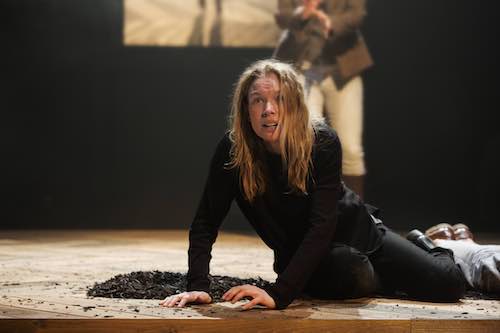 A Toronto adaptation of Hamlet features American Sign Language and a female lead
A Toronto adaptation of Hamlet features American Sign Language and a female lead
For its tenth anniversary, Why Not Theatre and director Ravi Jain re-visit their first-ever production: Prince Hamlet, Jain’s adaptation of Shakespeare’s Hamlet. For this new production the director set about—as described in the press materials—to “illuminate the contemporary relevance of the 400-year-old play and ask the question ‘who gets to tell this story?’”
It’s an ambitious challenge and while the result is by-and-large a solid production of Hamlet, I don’t think it quite hit the mark it set for itself.
For Prince Hamlet, Jain edited Shakespeare’s script, inter-cutting some scenes, abridging others, all the while still using Shakespeare’s dialogue. The end result is a Hamlet that’s more tightly-paced with a sense of flow that feels more film and television-like.
With the exception of Claudius (Rick Roberts) and Queen Gertrude (Karen Robinson), the director cast all roles in this adaptation with actors of the gender opposite to that of their characters.
That means that we have rare opportunity to see a female actor in the role of Hamlet. For her part, Christine Horne turns in a commanding performance as the brooding prince; she has a particular knack for portraying the character’s various states of mental instability.
Jain also cast Deaf actor Dawn Jani Birley in the role of Horatio and incorporates American Sign Language (ASL) throughout the play. Birley also serves as the ASL interpreter and is present on stage throughout the show. Birley is captivating in the role. She is integrated into the staging in a way where she becomes the silent narrator of the play.
However, for all of its updates, in my opinion Prince Hamlet still fell short in re-imagining its source material.
Though a female actor plays Hamlet, the role isn’t really gender reversed; the character still reads as male (or he is at least referred to throughout with male pronouns). The casting is merely gender-blind rather than gender-conscious.
I was really looking for the play to take on the implications and questions raised by a female Hamlet. Does the reversal of the genders affect the the power dynamics between the characters? Does it subvert traditional gender roles and challenge stereotypes in the process? How does the fact that Hamlet is played by a woman and Ophelia by a man change the nature of their relationship? These questions are mostly sidestepped in the work.
I had less of an issue with the incorporation of ASL; I applaud the effort to be inclusive and for the most part I think it was really well-done. I’ve just seen it done better, notably in the recent Broadway revival of Spring Awakening, where the incorporation of Deaf actors and ASL also created a fascinating layer of subtext for the show rooted in Deaf people’s history of repression and persecution.
Now, to be absolutely clear, it’s always refreshing to see actors on stage who reflect the diversity of the city at large and I’m all for challenging traditional gender roles. The thing is, I think this inclusive approach to casting the classics ought to be the default and ought not to be something noteworthy by now. I was really looking for this production to dig deeper and push farther in its attempt to find relevance and meaning for a contemporary audience.
Regardless, Prince Hamlet is a solid production of Shakespeare’s story. It’s well designed and features some spectacular lead performances. It just falls short of being revelatory.
Details:
- Prince Hamlet is playing from April 17 to 29, 2017 at the Theatre Centre (1115 Queen Street West)
- Shows run Monday to Saturday at 8:00 p.m., Saturday at 2:00 p.m.
- Tickets: Pay-What-You-Can-AFFORD $5–$75
- Tickets are available online.
Photo of Christine Horne by Bronwen Sharp.

“I think this inclusive approach to casting the classics ought to be the default and ought not to be something noteworthy by now.” That’s a lovely dream, but, looking at Toronto shows, it’s far from reality. Your comment drastically understates the dramatic risks taken in this production.
“I was really looking for the play to take on the implications and questions raised by a female Hamlet.” You may have missed the title of the play. It is Prince Hamlet, not Princess Hamlet. The characters have the same genders they always did. As a critic, why even see a play when you are going to reject the whole premise under which it was produced?